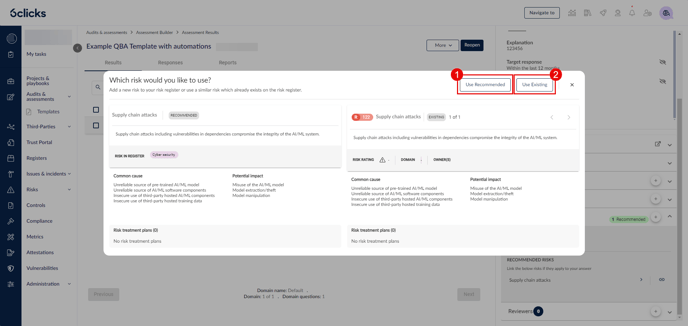Automating risks for Question-Based Assessments
Learn how to streamline the process of linking risks to Question-Based Assessment (QBA) answers
Table of contents:
Adding risk automation to an assessment template
Go to Audits & Assessments > Templates.
Create a new template or find the template you would like to automate risks for.
You are able to further edit any automations when creating an actual assessment based on this template.
In the template's Assessment builder tab (1), click on a question (2) that you would like to automate risks for, then select the Automations tab (3).
Click + Add automation to create an automation based on the answer.
Select the option/s you want to link a risk to, and click Link risks.
All risks currently in your libraries are displayed here. You can perform the following actions regarding this answer option.
- Select + next to a risk to link it; a green check indicates the risk has been linked (1).
- Select Linked to show all risks currently linked (2).
- Use the available search and filter functions to find your risks (3).
Click on the arrow next to each risk to view its details. Back out of the Linked rules view by clicking on the arrow next to it, and you can see that the answer now has the above ticked risk linked to it. There is also a cog icon that indicates automation next to the question.
Adding recommended risks when reviewing the QBA
While responding to the QBA, the respondents will not see any risks associated with their responses.
After the response is submitted and the assessment is in Completed status, you can review the QBA and link the recommended risks. To do this, go to the Responses tab of a completed QBA and select View next to the response you are reviewing.
When an answer to a question has risk automation, you will see risk recommendations.
Expand the Risks dropdown to see the recommended risks. You can link them from here or click into them to see their details.
A recommended risk from the risk libraries may already exist in the risk register. You can choose to create a new version of this risk on the risk register, or link the answer to the risk that already exists in the risk register.
You will be asked to Compare the recommended risk and the risk that exists on the risk register.
Compare the recommended risk with the risk that already exists on the risk register and choose to either create a new version of the recommended risk (1), or link the answer to the existing issue on the risk register (2).

Once the choice has been made, the risk will appear under Linked risks.








